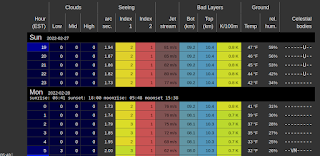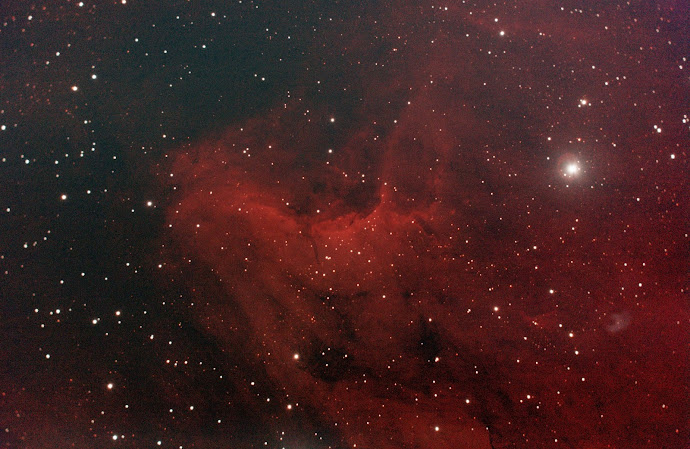02/27/2022 -- First light for 2022! After months of clouds, bright nights with full moons and temperatures too cold to tempt me outdoors, finally found an night with moderate temps, clear skies and near zero moon. Testing the indi_gphoto_ccd driver with the Panasonic GH5. Still running on batteries (not completely tethered) and connected to the venerable Meade LX200 at prime focus (2000mm @ f10) with an ambitious target (the galaxy NGC 3184) in the northern sky (mount set up and leveled on the back porch).


Started with a rough polar alignment with the polar scope -- no leaves on the trees, so no problem seeing Polaris from the back porch. Started ~7pm with setup and initial alignment. Employed PHD2 with rdesktop running on the Odroid XU4 (crashes when running locally via indi). Initial polar alignment error was -9.9' (31 pixels...DEC drifting up) with the ZWO Asi120mc-s through the RACI finder scope on the LX200. Tightend (likely way too much) on the right... polar error moved to 58.5'. Yikes! Tightened to the left... Back to 35.8... tightened again... now back to -18'. Time to tighten on the right. Finally converged at 5.6'.
Proceeded to focus the Meade LX200 with the GH5 on Tania Australis (close to the target NGC 3184). The OTA was originally focused for the Meade 0.67 focal reducer / field flattener, and so significant adjustment was required (6-7 turns clockwise) to bring the star into sharp focus. Used the live view zoom function on the GH5 to bring the star in tight for focusing.
Calibration with the internal guider (configured for pulse guiding with the Celestron mount) was successful and guiding comensed with ~1.58" RMS error (achieved at ~11pm).

Tried a capture with 120s exposure of NGC 3184 at ISO6400 on the GH5 to test exposure. Saved this remotely to /mnt/Astro/20220227. Discovered no electronic shutter exposures can exceed 1/24s. :(
Next reconfigured for normal shutter... and set the camera to bulb mode (with manual exposure setting on the camera). Restarted indi on the Odroid XU4 and requested a 120 second exposure in Ekos. The Indi Control Panel noted a 60 second exposure. :( Adjusted the 'force bulb' option from 'on' to 'off'. No change...next test also limited to 60 seconds. Exposures under 60 seconds (for example, a 20 second exposure) work as expected.
While perhaps workable for wideband collection, this would be a show stopper for any narrowband (Ha) collection.
ultimately, collected ~50 light frames until clouds rolled in around 2:30am.
In an attempt (albeit rather lame) just to see what a stacked image from the camera might look like, repeated collection on 02/28 when 94 additional light frames were obtained from ~12:30 to 3am. Thirty (30) flat frames (with the OTA pointed at the dawn sky in Aperture priority mode at the same ISO6400) were collected the next morning.
Additional attempts were made at more light frames on this target on 03/01 but the polar alignment wasn't double checked (mount stayed out...but clearly drifted in position) and no frames were obtained.
On 03/02/2022, the mount was re-aligned (during breaks in the clouds) by a rough polar scope alignment then a drift alignment (starting with an initial error in DEC of ~12'). Clouds and the threat of rain brought the equipment in. :<
On 03/03, with clear skies, no wind (but cold temps --33 degrees), tried again to capture some additional light frames with the GH5... just to see what a stacked product would look like. Seeing remains bad, but no moon and few clouds.
 |
| Cleardarkskies prediction for 03/03/2022 |
 |
| Meteoblue prediction for 03/03/2022 |
The indi-allsky camera with the Celestron NexImage 5 camera (with firmware update from The Imaging Source) came online for the first time this evening with astroberry running on the Raspberry PI 3b (charts visible on the local area network at https://10.25.1.208:444/indi-allsky/. Configuration settings need adjusting for gain and the fisheye is too wide... a longer focal length c-mount would be preferable to focus on the sky for backyard collections from the deck.
 |
| Indi Allsky example capture |
After leveling and an initial alignment with the polar scope, used phd2 from the Odroid XU4 over remote desktop to perform a drift alignment... which required no adjustment and reached less then 1'.
 |
| PHD2 drift alignment plot with polar error of 1.18'. |
Configured the scheduler and launched a collection job for NGC 3184. The internal guider in Indi/Ekos calibrated successfully and showed a guiding error RMS of ~2.3".
 |
| Indi/Ekos internal guider statistics with the Zwo ASI120MC-S through the 50mm RACI. |
Ultimately 110 light frames were collected from ~11:30pm to ~2:30am.
3/4/2022 -- Very little moon (~6%, waxing crescent, low in the sky), low temperatures (30's), little wind... are all great aspects for imaging tonight. However, high level clouds abound tonight ruining the odds of decent collection, but decided to check and see how the mount fared with regard to polar alignment overnight and over the day...and try to capture a few frames before the high level clouds really roll in. Initial PHD2 drift alignment showed a remarkable ~4' without any adjustment... suggesting the mount stayed still with no disturbances. Examined the frames collected by the GH5 through the OTA for plate solving and found the focus remained acceptable as well.
 |
Clear dark sky may represent high level clouds in the Transparency metric?
|
 |
| Forecast for 03/04 -- A very sad forecast for otherwise great conditions! :< |
 |
| PHD2 drift test results from 03/04 showing ~4.25" of error |
Even without adjustment, PHD2 drift alignment result via remote desktop on the Odroid XU4 showed little disturbance from the previous night's alignment. Yet another reason to cry with clouds!
Used the cloudy evening to collect bias and dark frames with gphoto scripting.















Comments
Post a Comment